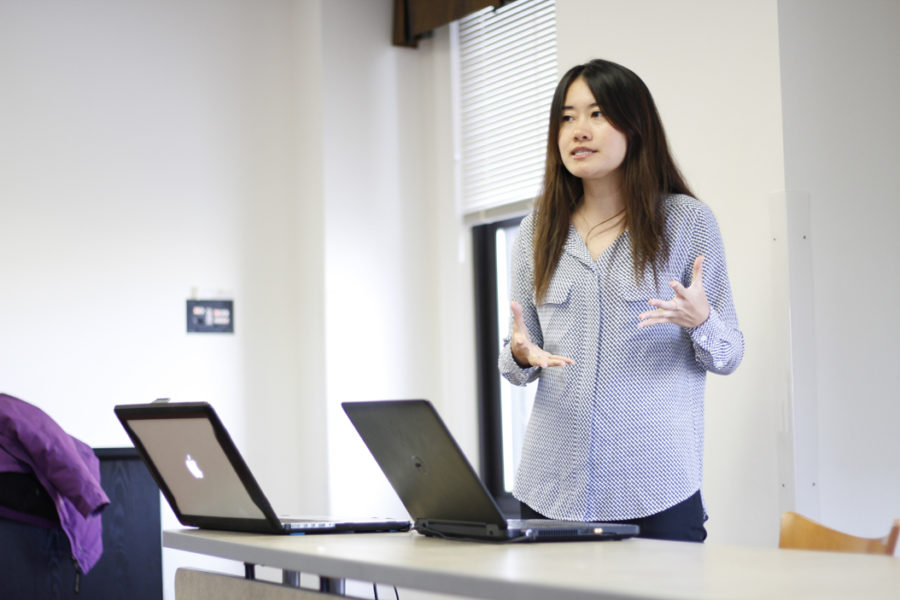When Pitt political science professor Iza Ding developed a cough while researching in China, her students joked her lungs were too “Westernized.”
Ding, who researches global and regional environmentalism in Eastern Asia and Central and Eastern Europe, said people in China, who deal with worse air pollution than those in the United States, often believe one can develop resistance to pollution.
“Some of my students have hurt me telling these jokes,” Ding said. “It’s a psychological strategy developed to normalize these issues.”
To increase awareness about these issues and other environmental concerns regarding climate change, Ding spoke to a crowd of 25 students about environmental politics and refugee displacement in the William Pitt Union Wednesday night from 6 to 7:30 p.m. The lecture, hosted by FORGE — a Pitt group for facilitating opportunities for refugee growth and empowerment — highlighted how the varying global stances on climate change is affecting the definition of a refugee.
During her lecture she shared her findings from her research on China, a country normally blanketed in smog that has recently been labeled a leader of climate change.
“What’s really interesting is that you would think it’s a compliment to say [that], but the response from China is quite interesting in that it does not want to take that responsibility and actually rejected that,” Ding said.
While Ding spoke of her research in China for much of the lecture, she also spoke about how climate change has affected people globally. Her global discussion focused on the displacement of people due to environmental factors.
Ding showed the crowd a global map from 2015 depicting the distribution of people who were displaced from their homes as a result of natural disasters, 98 percent of which were a result of climate change. Yet, the definition of a refugee still does not include those escaping from climate change-induced natural disasters, according to Ding, who said the accepted definition still comes from the 1951 UN refugee convention.
“Mass migration could be a new normal due to unchecked global warming,” Ding said. “It’s quite difficult for us to envision but the problems are actually really severe for these people.”
For example, the saltwater intrusion in Tuvalu — an island off the coast of New Zealand — has led to difficulty growing crops due to the increasingly unreliable water source, according to Ding.
In light of problems such as these, junior environmental studies and economics major Selaam Araya, said recent efforts were being taken to include environmentally affected people in the definition of refugee.
“This is my think piece,” Araya, whose parents became refugees from Eritrea when a drought heightened violence during its civil war, said. “I love talking about refugees and climate change, [they] are my academic interests.”
Since climate change is leading to more and more migration, the lecture fit the mission of FORGE, according to co-President Abigail Wang. Wang, a senior studying neuroscience, said the club has always addressed refugee issues through its events.
“What we like to do [with FORGE] is to help people on campus foster more empathy and understanding,” Wang said.
While Ding is sure that mass migration will be a side effect of global warming, she said there are several aspects of the phenomena that climate scientists still aren’t certain of, such as whether or not climate change is reversible, or how much worse climate change will become in future years.
Some effects of rising global temperatures are only evident through numbers, like statistics on ozone depletion and rising CO2 levels, other consequences are more visible, like coral bleaching and rising sea levels.
Almost 97 percent of climate scientists agree that human activities are responsible for rising global temperatures and environmental deterioration, but they are uncertain about the dynamics of global warming, such as the physics of shifting ice shelves or the possibility of reversing its effects, according to Ding.
“Global environmental change is not a linear process so it is difficult for us to predict its future,” Ding said.
Ding added that “glaciers are the most sensitive indicators of climate change,” as shown through rising sea levels and natural disasters such as floods and hurricanes, but others are “quite scary,” Ding said.
For example, in Siberia, because of rising global temperatures, bodies infected with smallpox — a disease last seen in 1977 — buried under the once-frozen Siberian ground are now being exposed to the air as global temperatures rise. The previously eradicated disease may be revived and spread as DNA containing the virus is now in the open.
In China, research has shown people living in the southern part of the country live five years longer on average than those in the north, where cities and air pollution are more prevalent. This prompts the question of what the country is actually doing to solve its environmental problems arises.
“In other countries, the problem is resolved after you make the law,” Ding said. “The problem in China is that [the laws] are never implemented.”
Ding said that countries, like humans, act in their self-interest, but in order for change to happen, countries need to recognize that climate change is a global issue.
“If we want to think about solutions to the global refugee issues, it is really important for us to take climate change and the problems associated with it into consideration,” Ding said.


